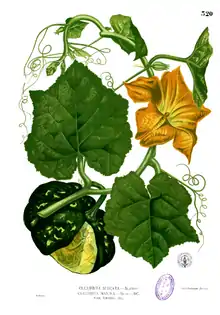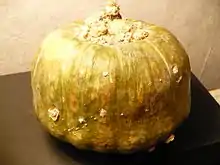Cucurbita maxima
Cucurbita maxima, one of at least four species of cultivated squash, is one of the most diverse domesticated species.[2] This species originated in South America from the wild Cucurbita andreana over 4000 years ago.[3] The two species hybridize quite readily but have noticeably different calcium levels.[4]
| Cucurbita maxima | |
|---|---|
 | |
| Scientific classification | |
| Kingdom: | Plantae |
| Clade: | Tracheophytes |
| Clade: | Angiosperms |
| Clade: | Eudicots |
| Clade: | Rosids |
| Order: | Cucurbitales |
| Family: | Cucurbitaceae |
| Genus: | Cucurbita |
| Species: | C. maxima |
| Binomial name | |
| Cucurbita maxima | |
| Subspecies | |
| |
| Synonyms[1] | |
| |
Types
Many cultivars of Cucurbita maxima have been developed. As in C. pepo, plants exist with a "bush habit" that is particularly evident in young plants, but older plants grow in the wild-type vining manner.[5]
- Arikara squash is an heirloom variety of C. maxima. Fruits weigh from four to eleven pounds. The shape of the fruit can be tear-drop or round, and they are colored in a mottled orange and green pattern. It is desired both for its eating qualities and as a seasonal decoration. This variety traces its ancestry to the Arikara tribe of the Dakotas, among whom its cultivation predates white settlement.
- Banana squash has an elongated shape, with light blue, pink or orange skin and bright orange flesh.
- Boston marrow sweet tasting, narrow at one end and bulbous at the other.[6]
- Buttercup squash is a common variety, with a turban shape (a flattish top) and dark green skin, weighing three to five pounds, and normally heavy with dense, yellow-orange flesh. Not to be confused with butternut squash.
- Candy Roaster squash is a landrace that was originally developed by the Cherokee people in the southern Appalachians. Another heirloom variety, it is quite variable in size (10-250+ lbs), shape (round, cylindrical, teardrop, blocky, etc.), and color (pink, tan, green, blue, gray, or orange), yet most have fine-textured, orange flesh. This variety enjoys continued popularity, particularly in the southern Appalachians.
- Hubbard squash is another cultivar of this species that usually has a tear-drop shape. It is often used as a replacement for pumpkins in cooking. According to one source,[7] the name comes from Bela Hubbard, settler of Randolph Township, Ohio in the Connecticut Western Reserve. Many other sources list an alternate history.[8][9] These sources state the hubbard squash (at the time nameless) came to Marblehead, Massachusetts through Captain Knott Martin. A woman named Elizabeth Hubbard brought the fruit to the attention of her neighbor, a seed trader named James J. H. Gregory. Mr. Gregory subsequently introduced it to the market using Mrs. Hubbard's name as the eponym. Gregory later bred and released the blue hubbard, which has a bluish-gray skin. The other major variety, the golden hubbard squash, has a bright orange skin. Gregory advertisements for the squash date from at least 1859.[10] The hubbard squash, including questions regarding the name, is even the subject of a children's ditty, "Raising Hubbard Squash in Vermont".[11]
- Jarrahdale pumpkin is a pumpkin with gray skin. It is nearly identical to 'Queensland Blue' and 'Sweet Meat' varieties.
- Kabocha is a Japanese variety with dark green skin and bright golden-orange flesh.
- Lakota squash is an American variety.
- Nanticoke squash is a rare heirloom variety that was traditionally grown by the Nanticoke people of Delaware and Eastern Maryland. It is one of only a few surviving Native American winter squashes from the Eastern woodlands.
- Turban squash, also known as "French turban", an heirloom predating 1820, and closely related to the buttercup squash.
Uses
Buttercup squash, a common cultivar, can be roasted, baked, and mashed into soups, among a variety of filler uses, much like pumpkin. It is extremely popular, especially as a soup, in Brazil, Colombia, and Africa.
All giant pumpkins (over 100 pounds or 45 kilograms) are of this species, including the largest pumpkins ever documented, which have attained a size of 2,624.6 pounds (1,190.5 kg) as of 2020.[12]
The seed of C. maxima is used in treating parasites in animals.[13]
Cultivation
Different squash types of this species were introduced into North America as early as the 16th century. By the American Revolution, the species was in cultivation by Native American tribes throughout the present-day United States. By the early 19th century, at least three varieties are known to have been commercially introduced in North America from seeds obtained from Native Americans. Secondary centers of diversity include India, Bangladesh, Myanmar, and possibly the southern Appalachians. The large red-orange squashes often seen at Halloween in the United States are C. maxima, but not to be confused with the orange type used for jack-o-lanterns, which are C. pepo.[14]
Gallery
 Typical "Zapallito" summer squash fruit.
Typical "Zapallito" summer squash fruit. A Pink Banana squash, cut, with seeds removed, with a U.S. quarter for size comparison.
A Pink Banana squash, cut, with seeds removed, with a U.S. quarter for size comparison. A buttercup squash.
A buttercup squash. An edible squash
An edible squash A cut open blue hubbard squash.
A cut open blue hubbard squash. A golden hubbard squash.
A golden hubbard squash. Different fruit types of C. maxima ssp. andreana from Argentina[15]
Different fruit types of C. maxima ssp. andreana from Argentina[15] A vining cultivar growing up to a roof.
A vining cultivar growing up to a roof. Plant
Plant Plant
Plant
References
- "Cucurbita maxima". The Plant List. Retrieved November 15, 2014.
- Ferriol, María; Picó, Belén; Nuez, Fernando (2004). "Morphological and Molecular Diversity of a Collection of Cucurbita maxima Landraces". Journal for the American Society for Horticultural Science. 129 (1): 60–69. doi:10.21273/JASHS.129.1.0060.
- Sanjur, Oris I.; Piperno, Dolores R.; Andres, Thomas C.; Wessel-Beaver, Linda (2002). "Phylogenetic Relationships among Domesticated and Wild Species of Cucurbita (Cucurbitaceae) Inferred from a Mitochondrial Gene: Implications for Crop Plant Evolution and Areas of Origin" (PDF). Proceedings of the National Academy of Sciences of the United States of America. Washington, DC: National Academy of Sciences. 99 (1): 535–540. Bibcode:2002PNAS...99..535S. doi:10.1073/pnas.012577299. JSTOR 3057572. PMC 117595. PMID 11782554.
- Skilnyk, Hilary R.; Lott, John N. A. (1992). "Mineral analyses of storage reserves of Cucurbita maxima and Cucurbita andreana pollen". Canadian Journal of Botany. 70 (3): 491–495. doi:10.1139/b92-063.
- Mark G. Hutton and R.W. Robinson. "Gene List for Cucurbita spp". Retrieved 16 November 2014.
- "Boston Marrow Squash". Rare Seeds. Retrieved September 3, 2013.
- Troyer, Loris C. (1998). Portage Pathways. Kent, OH: Kent State University Press. p. 8. ISBN 978-0-87338-600-5.
- Watson, Ben (1996). Taylor's Guides to Heirloom Vegetables: A Complete Guide to the Best Historic and Ethnic Varieties. Boston: Houghton Mifflin Harcour. p. 268. ISBN 978-0-395-70818-7.
- "James J. H.Gregory: A Timeline of his Life". SaveSeeds.org. Archived from the original on November 3, 2014. Retrieved November 15, 2014.
- Downing, Andrew Jackson (May 1859). The Horticulturalist, and Journal of Rural Art and Rural Taste. 14. New York: C. M. Saxton, Barker & Co. p. 4.
- Cady, Daniel Leavens (1919). Rhymes of Vermont Rural Life. Rutland, VT: The Tuttle Company. p. 100.
- "World Record Achievements". GiantPumpkin.com. Retrieved November 1, 2020.
- Díaz, Obregón D.; Lloja, Lozano L.; Carbajal, Zúñiga V. (2004). "Preclinical studies of cucurbita maxima (pumpkin seeds) a traditional intestinal antiparasitic in rural urban areas". Revista de Gastroenterologia del Perú (in Spanish). 24 (4): 323–327. PMID 15614300.
- Nee, Michael (1990). "The Domestication of Cucurbita (Cucurbitaceae)". Economic Botany. New York: New York Botanical Gardens Press. 44 (3, Supplement: New Perspectives on the Origin and Evolution of New World Domesticated Plants): 56–68. doi:10.1007/BF02860475. JSTOR 4255271. S2CID 40493539.
- Millán, R. (1945). "Variaciones del zapallito amargo Cucurbita andreana y el origen de Cucurbita maxima". Revista Argentina de Agronomía (in Spanish). 12: 86–93.
External links
 Data related to Cucurbita maxima at Wikispecies
Data related to Cucurbita maxima at Wikispecies Media related to Cucurbita maxima at Wikimedia Commons
Media related to Cucurbita maxima at Wikimedia Commons
